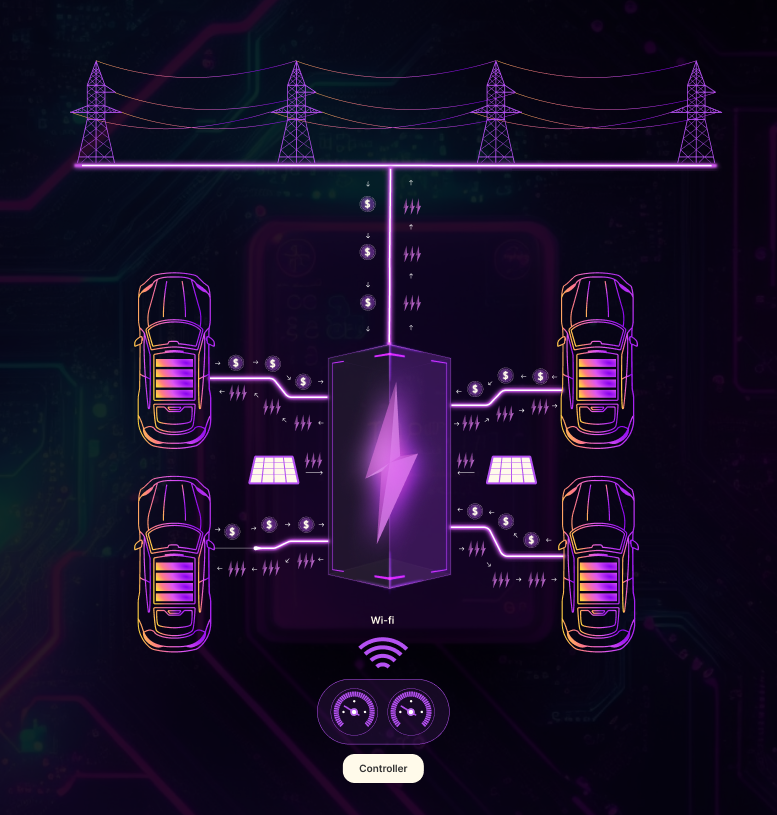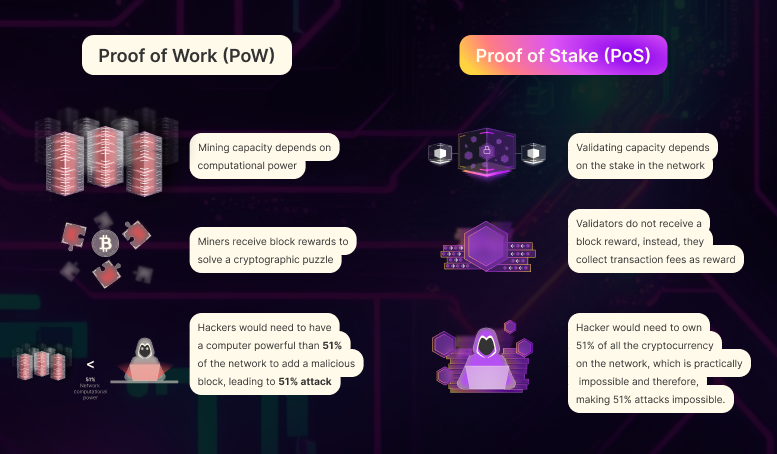What is Staking: The Basics and Benefits of Crypto Staking

Staking crypto has emerged as a popular way to earn passive income. Who doesn’t dream of making money from their crypto portfolio while sleeping?
Staking has become so popular that the global staking market capitalization stands at $310 Billion as of this writing. This value is just outside the 10th largest bank in the United States.
But what is staking? And why have so many people jumped on board this novel concept?
We’ll answer these questions throughout the article.
If that interests you, get ready to dive into the world of staking as we tackle the basics and benefits of this revolutionary approach to cryptocurrency investing.
What is staking?
Proof of Stake (PoS) Staking
Consider staking cryptocurrencies like establishing an electric vehicle (EV) charging station. Through this station, you contribute directly to the EV infrastructure and help make a world free from fossil fuels possible. Other EVs can charge at your station; you receive payments.
Crypto stakers operate similarly.
In staking, you set up a computer that connects to the blockchain, adding to the overall network infrastructure. Then, you deposit a portion of your cryptocurrency to support the operations of the said network. In return, you receive staking rewards determined by the amount and duration of the coins you stake.
For example, Crypto staking with Ethereum, the 2nd largest cryptocurrency by market capitalization, can earn 3.3% per year. If you placed 32ETH, you’d get back around 1.056ETH in rewards after a year.
Multi-Asset Staking (MAS)
Picture multi-asset staking cryptocurrencies as placing your money in a peer-to-peer lending platform. Such platforms allow individuals to lend their money to others in exchange for interest payments. Borrowers hopefully make good use of your money in their creations or business operations, and you will receive the rewards.
In MAS, a user may deposit cryptocurrency X but receive reward Y, which gives it the multi-asset terminology.
While you also lock your cryptocurrency, multi-asset staking should be distinct from PoS Staking; the latter supports the blockchain’s infrastructure, operations, and security. In MAS, a user deposits tokens to a crypto staking platform, lending these cryptocurrencies to protocol borrowers.
For this guide, we will be discussing Proof of Stake (PoS) Staking.
Why Go Proof of Stake
Traditionally, blockchains used proof-of-work (PoW) mechanisms to verify transactions on the network. Also called mining, PoW requires lots of physical hardware and electricity consumption.
The high energy costs have led miners to flock to countries with more affordable electricity. At the same time, hardware has been getting expensive. Mining operations eventually focused on a few players, turning what is supposed to be a decentralized activity into a centralized one.
Newer blockchain networks adopted the proof-of-stake (PoS) consensus algorithm, otherwise known as staking, to address these high energy costs and centralization,
While physical infrastructure is still needed to run the system, staking crypto does the heavy lifting. You then become an active participant in the network, helping to validate transactions and secure the blockchain.
Under staking, physical hardware is not that important. Instead, the amount and duration of coins you staked play a significant role.
Benefits of Staking
Aside from keeping the network secure and operational, crypto staking provides many other positives.
Earn Passive Income
Staking allows you to earn passive income by locking up your cryptocurrency holdings in a blockchain. In return, you receive staking rewards in the form of additional tokens. This passive income opportunity is an excellent way to generate consistent returns on your investment, especially if you aren’t into trading.
Participate in Network Governance
Many blockchain networks that support crypto staking also allow participants to have a say in network governance. Stakers vote on proposals or changes to the network’s protocol, giving you a voice in the direction of the blockchain.
MakerDAO, the network behind the DAI stablecoin, was one of the first projects to implement governance. Holders of MakerDAO are entitled to vote on the future of the blockchain. View some of the proposals here.
Reduce Energy Consumption
If Bitcoin were a country, in terms of energy consumption,it would rank 29th ahead of Argentina. When Bitcoin first came onto the scene in 2009, a person could mine several bitcoins from their desktop. Nowadays, companies set up warehouses of machines to mine a single bitcoin.
With crypto staking, a person needs to set up a single computer, hold crypto in their wallet, and lock this up into the blockchain network. Stakers can perform staking from one’s home.
Furthermore, staking encourages long-term holding of cryptocurrencies, reducing market volatility and creating a more reliable market.
Different Types of Staking
When it comes to staking your crypto assets, a handful of options exist for you to earn rewards. You must evaluate each option’s reward structure, technical difficulty, and security.
Solo Staking (AKA Self Staking)
Under this method, a cryptocurrency holder stakes their tokens or coins on a blockchain network without relying on a third party or a staking pool.
Let’s use Ethereum, a PoS blockchain network, as an example:
- Users must set up their node, which operates and stores a copy of the Ethereum blockchain. A node can run on a single computer and operates 24/7. Nodes contribute to the overall decentralization of the network by having various machines worldwide store a copy of the network’s data. While you are not necessarily earning staking rewards as a node operator, you do play a significant role in the overall health of the blockchain.
- You must turn this node into a validator to earn a staking reward. You must deposit 32 ETH ($113,000 in today’s prices). Validators verify the transactions on the network. By having a deposit, you now have skin in the game. Malicious validators can lose their entire deposit.
- In return for validating transactions, the staker receives transaction fees as fresh ETH.
Solo Staking is the most secure and rewarding method, as you cut out middlemen and retain direct crypto ownership. However, it’s also the most complex. This high capital entry and comfortability with computers may bar some people from pursuing self-staking.
Staking Pools
Under pooled staking, an interested staker needs access to a wallet or crypto exchange account and sufficient crypto.
Coinbase and Gemini, centralized exchanges, operate crypto staking platforms through a liquid staking service. In this arrangement, a holder deposits their tokens into the crypto staking platform and receives a liquid staking token (LST) of equivalent value in return.
The deposited token is pooled and goes on to perform network validation. Meanwhile, the LST may be used for trading on other protocols, thus providing liquidity to the staker to maximize rewards.
Decentralized protocols such as Rocketpool allow stakers to join another staking pool, thereby slashing down the barriers to entry. Rocketpool users can join staking pools for as low as 8ETH, reducing the initial cost by 75%.
With their technical ease and lower capital requirements, staking pools have become popular options among crypto stakers. Lido, a liquid staking protocol, runs the largest staking pool platform, with USD33 Billion staked.
Staking vs. Mining
Staking (Proof-of-Stake) and Mining (Proof-of-Work) are different methods for validating transactions and securing blockchain networks. Earlier cryptocurrencies, such as Bitcoin, relied on mining. Newer crypto, such as Ethereum, Cardano, and Polkadot, use staking.
Mining
Miners race against each other to solve complex mathematical problems to validate transactions (stored in a block) and receive new coins as a reward.
The original creator programmed Bitcoin rewards to diminish roughly every four years when the reward is halved (known as Bitcoin halving). As a result, miners become even more competitive and upgrade their computer equipment or pool together. This arms race for the most computing power requires large energy consumption.
Staking
A PoS consensus mechanism similarly works with nodes to validate transactions and secure the network. Instead of how much computer power you have, the rewards are handed out based on the number of coins and the duration you stake.
Staking is considered to be more accessible than mining, as it requires less specialized hardware and technical expertise.
Risks and Challenges of Staking
While staking offers numerous benefits, it’s essential to be aware of the risks and challenges involved:
Market volatility
Staking yields reflect returns based on the current market price of the staked asset. Unless you have placed assets in less volatile projects such as stablecoins, a wild swing in prices can impact the value of your assets and diminish your crypto income.
Technological risks
Proof-of-stake consensus runs on smart contracts, defined as self-executing contracts with the terms of the agreement directly written into code. A protocol may have smart contract flaws, such as delays or freezes in sending staking rewards.
PoS validator nodes could also vote or act poorly and try to attack the network by halting and possibly reversing transactions. Those are rare, however, and PoS has made it difficult for attackers as it would require owning 51% of the protocol’s token supply.
Regulatory uncertainty
Global regulators have yet to familiarize themselves with cryptocurrency. As such, many governments have yet to solidify their policies around it. In February 2023, the U.S. Securities and Exchange Commission (SEC) alleged that crypto exchange Kraken sold unregistered securities through its staking as a service offering. The SEC ordered the shutdown of Kraken’s US-based staking operations and a $30M fine.
Many more significant risks exist. That’s why thorough due diligence is essential before committing to stake crypto.
Centralized vs. Decentralized Storage of Cryptocurrency
You may have heard of the famous phrase, “Not your keys, not your crypto.”
Opening a crypto exchange account and depositing your digital assets into the platform can be tempting. These big exchanges take hold of your crypto, safeguard it, and offer you a wide range of services.
However, should anything happen to the platform or worse, should the people operating the exchange act maliciously, you’ll most likely lose all your assets as the exchange ultimately handles it. Such was in the case of FTX, the previous 2nd largest crypto exchange.
On the other hand, decentralized crypto wallets empower you to retain cryptocurrency ownership. As long as you safeguard your keyphrase, even if the company behind the crypto wallet goes down, you can still access your cryptocurrency through another wallet, as your keyphrase gives you direct access to the blockchain.
You can classify decentralized wallets into hot, cold wallets, and hardware wallets.
Hot Wallets
Hot wallets are convenient and can connect to the internet and decentralized applications. You can download these applications from any computer worldwide with your keyphrase. Famous wallets such as Metamask and Phantom Wallet come to mind.
Hardware Wallets
Meanwhile, hardware wallets are devices specifically built to store cryptocurrency safely. They usually come in a USB and only go online once you connect it to a computer and the internet. Brands such as Ledger and Trezor have made a name for themselves through these devices.
Cold Wallets
Finally, cold wallets are paper- or file-based wallets that store one’s keyphrase and crypto address. Yes, you read that right – you can create your cold wallet by handwriting or printing your keyphrase on a piece of paper and locking it up in a vault. Similarly, it could be a text file stored on a USB.
That’s not to say these methods are foolproof. Malicious actors constantly prowl to drain an unsuspecting user’s wallet. Mark Cuban lost nearly $1 Million in crypto upon downloading an unsafe version of Metamask.
Is Crypto Staking Worth It?
Crypto staking is worth it if you’re willing to do thorough research, understand the risks involved, and choose the right cryptocurrency and staking methods, staking can be rewarding and profitable. It allows you to actively participate in the blockchain ecosystem while potentially earning additional tokens and generating a passive income stream.
Crypto staking provides numerous benefits, such as the potential for earning rewards, network security, and a more eco-friendly approach compared to mining.
However, the crypto space comes with many risks. Crypto staking is not a guaranteed way to earn income and can lead to capital losses.
Many new blockchain networks have launched and encouraged holders to stake their tokens. Unfortunately, these token prices have fallen from 50% to 80% of their original value, more than outweighing the staking rewards.
On the other hand, more established networks, such as Ethereum, have maintained a low staking rate while maintaining its token prices. Stakers would profit from such networks.
So, if you’re ready to unlock the potential of staking and take advantage of its benefits, start exploring the staking world today.
Happy staking!
Editor’s Note: This article was originally published in October 2023 but has been updated with new information.
The content of solostakers.com is for informational purposes only and should not be considered financial advice. It represents the personal views and opinions of the author(s) and is not endorsed by any financial institution or regulatory body. Cryptocurrency and staking investments carry inherent risks and readers should conduct their own research and consult with a financial professional before making any investment decisions. The owner and author(s) of solostakers.com will not be liable for any losses, damages, or consequences arising from the use of the information on this site. By accessing solostakers.com, you agree to bear full responsibility for your investment decisions.
June 28, 2024
November 14, 2025






